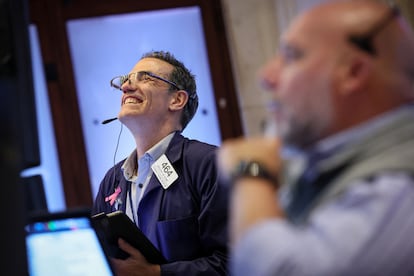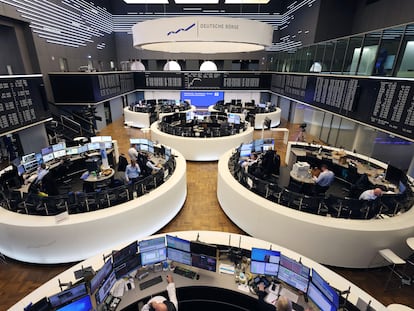Wall Street declares a state of permanent happiness: The markets are up by 150% since the pandemic (and nobody sees the ceiling yet)
The U.S. stock market is at an all-time high, driven by technology shares. Analysts continue to consider equities as being the best investment option for the second-half of the fiscal year

The financial world is beginning the second-half of 2024 full of uncertainties, but with the stock markets — especially the American ones — at historic highs. Neither geopolitical tensions, nor abrupt increases in interest rates, nor inflationary pressure, nor sluggish global economic growth have made a dent in equities. Energy and technology companies have further driven the rise in stock prices. Will we see stocks finally hit their ceiling in the second-half of the year? Well, few of the experts consulted by EL PAÍS were willing to make such a categorical statement, especially as corporate profits continue to hold up.
On a purely economic level, the keys to semi-annual investment strategies will, once again, be the usual suspects of recent times. These major factors include the evolution of inflation in large economies and the logic derived from the decisions made by central banks. This past June 6, for instance, the markets were wrong again, having expected a rapid rate cut in both the U.S. and Europe. In the end, the eurozone saw a reduction of only a quarter-of-a-point — down to 4.25% — while the U.S. Federal Reserve kept the rate anchored at 5.5%, pending the evolution of prices and the strength of the American economy.
All bonds issued by developed countries have shown rising yields since the beginning of the year. The case of France stands out: after the European elections and last week’s unexpected legislative results — with the extreme-right being blocked in the second round — 10-year bonds now offer yields of 3.25%, compared to the figure of 2.68% from the start of 2024. The euro, meanwhile — after all the EU election turbulence — has lost 3% of its value against the dollar since January, with an exchange rate standing at $1.08.
The strength of the stock market has been another big surprise in the first-half of 2024. Traders adapted to the new situation, which has been summarized by the Federal Reserve as “higher rates for longer.” In Europe, the quarter has ended with increases of around 10% (even higher than the impressive gains made in 2023), while in the United States, the technological push — now driven by artificial intelligence (AI) — saw the Nasdaq gain more than 18%, with a 15% rise for the S&P 500.
The challenges or threats in the new quarter — which has just begun — aren’t limited to inflation. Politics affected the markets with the recent elections for the European Parliament and the general elections in France and the United Kingdom. This will happen again in November, when the U.S. presidential elections are held, opening up the doors to volatility and uncertainty. Investors will also be watching increasingly complex and alarming geopolitics, with the war between Israel and Hamas in Gaza and the Russian invasion of Ukraine.
Raphaël Gallardo — chief economist at Carmignac, an asset management firm — summarizes that “we’ve entered a ‘Cold War II,’ which started with Russia’s invasion of Ukraine. It’s a trade war, a financial war, a conventional arms race and a technology race. We expect an escalation of tensions in the second-half of the year.”
Below are the experts’ forecasts for the principal asset classes in the second-half of the year.
Variable income
Stock markets have been soaring since the beginning of 2024, with double-digit increases. Generally speaking, financial advisors will continue to bet on equities for the remainder of the year. Of course, they present the bet in a Manichean way: the United States against Europe, large corporations against small and medium-sized companies, or technology companies as opposed to energy and public service companies. The stock markets have successfully coexisted with the rise in long-term interest rates. We will now have to see how they perform in a phase of slashed rates.
The key to the optimism about stocks is that — according to market consensus — companies will continue to increase their profits throughout the remainder of the year, with a U.S. economy in a gentle process of deceleration and an eurozone that’s already beginning to grow. Luca Bindelli — the head of investment strategy at Lombard Odier, an independent Swiss banking group — forecasts that profits will grow by 11% in the U.S., 3% in Europe and 6% in the U.K. The consensus of financial analysts puts expectations at 11%, 5% and 2%, respectively. Along these same lines, Rafael Alonso — a banking sector analyst at Bankinter — feels that investing in the stock market is increasingly attractive, due to economic growth, the moderation of inflation, as well as falling interest rates that will allow business profits to increase, due to greater borrowing and investment.
Forecasts speak of more corporate profits on Wall Street compared to Europe, but many analysts prefer the eurozone as a place to invest. The explanation is that the U.S. stock market is more expensive to invest in than the European one, a premise that was also posited at the beginning of 2024. However, this hasn’t prevented the U.S. market from leading the pack.
Luca Paolini — chief strategist at Pictet Asset Management — sees greater potential in “eurozone stocks, Switzerland and Japan, with much more attractive valuations than in the U.S., [which is] by far the most expensive region.” Even so, he sees no signs of a bubble on Wall Street, which is showing solid profits. “Additionally, we hope that the good performance of the information technology and communication services sector will continue,” he tells EL PAÍS.
Luis Artero — director of JPMorgan Private Bank in Spain — is also optimistic about the European stock market. He’s relying on its low valuation, the fact that it’s trading at 13 times the expected profits, the share buybacks that companies are carrying out, as well as the fact that 70% of sales made by European multinationals take place abroad. “We foresee a profit growth of 6%, which would lead the European market to rise by 13% in the next 12 months, while the U.S. stock market would barely appreciate in that period,” he opines.
Claudio Wewel — a currency strategist for JSS Sustainable Equity — is also opting for European shares, “given that the rebound in the manufacturing sector should especially help the eurozone’s economy, which is driven by exports.” He adds that “Europe has also created its own group of large-cap leaders in sectors such as healthcare, semiconductors and retail. [There has also been] a 62% increase in military spending since a decade ago. The order books of European weapons contractors have swelled.”
However, the recent European elections have altered the sentiment of some analysts. Citibank changed its mind during the close elections in France, preferring investment on Wall Street over the Old Continent, due to the political risk in the eurozone. In a recent study, Natixis Investment Managers warns that the problems facing France — mainly regarding the control of public spending — can extend to all countries.
Wellington Management’s strategy team also prefers the U.S. and Japan over Europe and emerging markets: “Consequently, they add, this makes them prefer the U.S. and Japan over Europe and emerging markets. We consider the former as our main developed market due to the macroeconomic context and our confidence in the potential of AI to continue underpinning earnings growth,” the firm notes. “We have a moderately overweight view on Japan and remain skeptical of a material improvement in China, given the real estate and consumer confidence issues.”
At Goldman Sachs, they maintain their commitment to “large U.S. shares and emerging equities.” Regarding Europe, the global investment bank believes that the current inflection of earnings dynamics, together with the improvement in the macroeconomic climate and the first cuts in official interest rates, “could benefit the small and mid-cap segment.”
This forecast by analysts and asset managers — along with Deutsche Bank — for smaller listed companies was also repeated as a mantra for investing at the beginning of the year, supported by predicted rapid rate cuts that would alleviate the financial burden on more modest firms. But this hasn’t completely materialized. However, Claudio Wewel indicates that small securities in the eurozone will benefit from the currency depreciation that comes with eventual rate cuts, due to increased exports and domestic substitution for imported goods. And Michel Saugné — co-director of investment at LFDE, one of France’s leading asset management companies — estimates that “very attractive entry points will soon appear in European equities, especially in [smaller firms].” In general, the French expert shows his optimism about stocks, indicating that risk assets still have potential.
Bonuses
Last quarter, with interest rates expected to fall, investors bet on long-term bonds, with the expectation of a drop in yields and, therefore, a rise in existing fixed-rate bond prices. This ended up being a fiasco. Ten-year bonds now offer higher returns than at the beginning of 2024, meaning that existing fixed-rate bond prices have dropped, due to investors desiring newly-issued bonds. Of course, the returns they offer still remain highly-attractive compared to the not-so-distant times of near-zero interest rates in Europe and the United States, when governments slashed rates to reduce borrowing costs and stimulate growth.
At the beginning of 2024, inflationary pressures returned and the expected rate reduction — which has been a long time coming — only materialized in the European Central Bank with a cut of 0.25 points, bringing the interest rate down to 4.25%. In the United States, high inflation and economic strength have postponed the Federal Reserve’s rate cuts. Meanwhile, in Europe, the elections to the European Parliament and the fiscal deficit in France have given rise to insecurities that can infect the rest of the EU members. This scenario of volatility that affects governance is also transferred to the markets, where companies are already dealing with the issue of solvency.
Jim Cielinski — the global head of Fixed Income at Janus Henderson Investors — explains the situation that conservative investors find themselves in: “Outside of a major growth surprise or inflation shock, we struggle to see major central banks raising rates. The risk to rates markets, therefore, is that cuts are fewer and slower than expected. As such, we prefer European markets over the U.S., where Europe’s relatively weaker economy offers more visibility of a lower rates trajectory.” Lower-performing economies tend to result in governments reducing interest rates to generate growth.
Furthermore, Ciellinski is clearly betting on fixed income: “Elevated political risk in the second half of 2024 should draw investors to assets that are traditionally lower risk, such as bonds, which offer some protection against a more pronounced slowdown or an escalation in geopolitical risks.”
But Thomas Maxwell — investment director of the management company Abrdn — looks to the short-term for this volatile moment in bond markets. ”We find short maturity investment-grade corporate and government bonds particularly appealing. These investments can deliver strong total returns in most scenarios,” he wrote in The Financial Times back in May.
“Our favorite segment within the credit market is short-dated corporate bonds, with one to five-year maturities,” he continued. “These investments work in various scenarios and offer attractive returns.”
In the case of Goldman Sachs, its experts share this vision, betting on European bonds, where the path towards falling prices and eventual lower rates is clearer. They’re looking towards short-term corporate bonds, preferring to stay away from high-risk, high-yield equities.
Currencies, gold, oil
Experts say that — of all the financial markets — the currency market is always the most difficult to predict, due to the numerous variables that affect it. However, the recent European elections are leaving the outlook clearer, with the fall of the euro against the dollar and the possibility of a return to parity between both currencies. A recent report from Barclays indicates that, for every 15 basis points that the risk premium on France’s 10-year bonds rises, the euro falls by 0.7%. In this vein, Citibank analysts hypothesize that, if French President Emmanuel Macron were to resign, the risk premium would rise to 135 basis points, with the euro falling to equal $1.02.
At Goldman Sachs, they believe that, with a more protectionist U.S. economy — a possible result of the presidential elections in November — the greenback could strengthen against the rest of the world’s currencies. Pedro del Pozo — director of financial investments at Mutualidad — thinks that the euro-to-dollar exchange rate will remain within $1.05 and $1.11 per euro, with a certain tendency towards the low zone in the short-term, “derived from the greater dynamism of the American economy.”

Closely linked to the price of currencies is gold, an asset in which analysts see a lot of potential. Bank of America points to a possible revaluation to $3,000 per ounce (it’s now trading at $2,325). This forecast is based on financial interest in gold, which will rise in value when the US begins to slash interest rates (as bank deposits won’t get as great a return). “Ongoing purchases by central banks are also important, a push to reduce the dollar’s share [within] currency portfolios will likely lead to more gold purchases,” explains James Luke, a fund manager at Schroders. “Geopolitical and fiscal fragility are combining to forge a path towards a sustained and multipronged global pull on gold supplies. This could trigger, we think, one of the strongest bull markets since President Nixon closed the gold window in November 1971, ending the convertibility of the U.S. dollar into gold.”
In the case of another key asset — oil — a barrel of Brent Crude is trading at around $87, or 10% higher than at the start of 2024. The importance of its evolution is clearly visible, given its effect on inflation and, as a result, on interest rates. In the oil market, opposing forces are battling it out when it comes to price expectations, including OPEC’s production cuts, greater global economic dynamism and geopolitical risk. On the other hand, there has been slightly less demand for crude, due to lower economic activity and the gradual substitution of fossil fuels.
Pedro del Pozo expects a barrel of Brent Crude to hover around $85 in the second-half of the year, likely closer to $80. “Obviously, an unforeseen and significant detente in the Middle East and Ukraine — or a strong and unforeseen economic slowdown — can modify this scenario clearly downwards,” he tells EL PAÍS.
Francisco Blanch — the head of global commodities and equity derivatives at Bank of America — highlights that oil inventories have increased by 1.7 million barrels a day since mid-February, driven in part by global oil demand growth slowing to 890,000 barrels per day year-over-year in the first quarter of 2024. He thinks that oil prices will ease if stockpiles continue to be built up. The evolution of China — the main consumer of crude — will also be key to the energy market in the coming months.
Sign up for our weekly newsletter to get more English-language news coverage from EL PAÍS USA Edition
Tu suscripción se está usando en otro dispositivo
¿Quieres añadir otro usuario a tu suscripción?
Si continúas leyendo en este dispositivo, no se podrá leer en el otro.
FlechaTu suscripción se está usando en otro dispositivo y solo puedes acceder a EL PAÍS desde un dispositivo a la vez.
Si quieres compartir tu cuenta, cambia tu suscripción a la modalidad Premium, así podrás añadir otro usuario. Cada uno accederá con su propia cuenta de email, lo que os permitirá personalizar vuestra experiencia en EL PAÍS.
¿Tienes una suscripción de empresa? Accede aquí para contratar más cuentas.
En el caso de no saber quién está usando tu cuenta, te recomendamos cambiar tu contraseña aquí.
Si decides continuar compartiendo tu cuenta, este mensaje se mostrará en tu dispositivo y en el de la otra persona que está usando tu cuenta de forma indefinida, afectando a tu experiencia de lectura. Puedes consultar aquí los términos y condiciones de la suscripción digital.
More information
Archived In
Últimas noticias
Welcome to the post-religion era: The idea of Christianity as the absolute truth has become obsolete
‘I thought you would like it’: The risky sexual practice popularized by TV shows and TikTok
The digitalization of tourism: ‘They promise experiences and gave us the worst possible one’
Mexican peso defies uncertainty with forecasts of a new period of stability in 2026
Most viewed
- Sinaloa Cartel war is taking its toll on Los Chapitos
- Reinhard Genzel, Nobel laureate in physics: ‘One-minute videos will never give you the truth’
- Oona Chaplin: ‘I told James Cameron that I was living in a treehouse and starting a permaculture project with a friend’
- Why the price of coffee has skyrocketed: from Brazilian plantations to specialty coffee houses
- Silver prices are going crazy: This is what’s fueling the rally










































